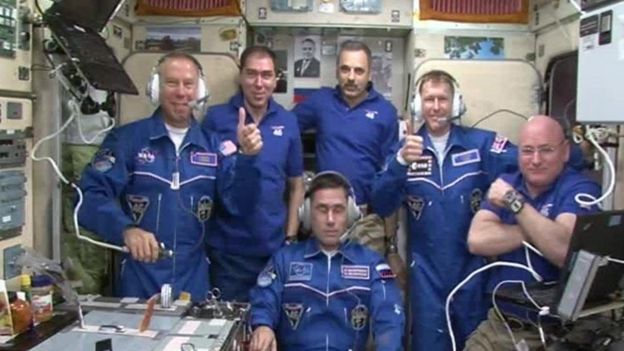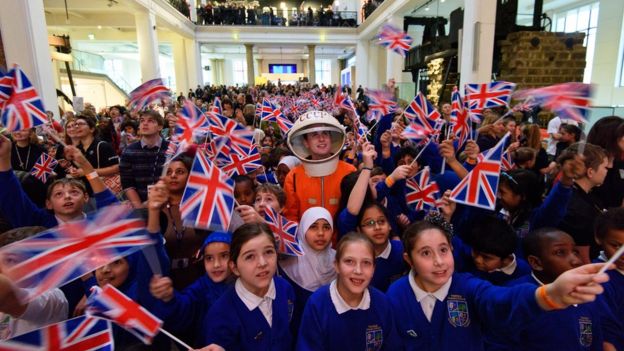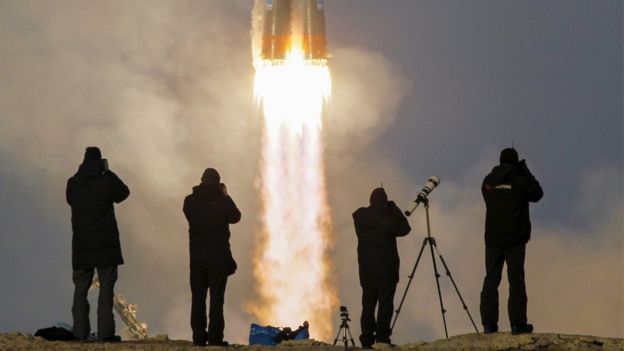UK astronaut Tim Peake has boarded the International Space Station, which will be his home for the next six months.
Mr Peake and fellow crew members, Russian Yuri Malenchenko and American Tim Kopra, floated through the hatch from their Soyuz space capsule to be greeted by the resident ISS astronauts.
The three new passengers arrived at the space platform following a six-hour journey after launch from Kazakhstan.
Mr Peake is making history as the first official UK astronaut.
'Beautiful launch'
Speaking from the ISS to officials and family members, he said: "It was a beautiful launch. That first sunrise was absolutely spectacular.
"We also got the benefit of a moon rise which was beautiful to see."
And he gave a thumbs up to his wife, Rebecca, who told him: "It was fantastic to watch that launch today.
"There were quite a few parties down on the ground, so your launch was well celebrated by everybody down here.
"Have a great mission. We love you."

Analysis: Paul Rincon, science editor, BBC News online
It's a rare event for the Soyuz crew to have to manually dock the spacecraft at the space station.
The Kurs radar system that failed is one of the two main ways controllers have of determining where the Soyuz is relative to the space station.
The other is measurements taken from the ground.
The immense skill required to manually dock the capsule in open space is exactly why Tim and the other crew members undergo such rigorous training for a range of different failure scenarios.
Mr Peake was waved off by his wife and two sons, Thomas, six, and Oliver, four, at the Baikonur Cosmodrome in Kazakhstan earlier on Tuesday.
Sitting on the shoulders of his grandfather, the youngest son cried loudly, saying: "I want to go with Daddy."
The launch was from the same place where Yuri Gagarin became the first human in space in 1961.
There were no reported problems during the blast-off.
However, docking with the space station - which is regarded as one of the most difficult stages of the journey - did not go entirely to plan.
The Russian commander had to steer the spacecraft in manually about 10 minutes after its scheduled docking time of 17:24 GMT.
'Hazardous'
Mr Peake's mother, Angela, who was watching the docking live from a cinema near the launch site, said: "I'm feeling relieved. I wasn't really tense, I just feel quite reassured by those around me - they have a lot of experience."
Speaking before the launch, Mr Peake had said: "Any time two vehicles come in close proximity in space is hazardous.
 Getty Images
Getty Images Reuters
Reuters
"The docking needs to be closely monitored and you have to make sure you're on target and on speed."
It takes four orbits of Earth and about six hours to reach the ISS.
In their new home, the crew will work, sleep and exercise in a dozen modules, together about the same volume as two Boeing 747s.
The three crew members join the existing taskforce on board the ISS - Nasa astronaut Scott Kelly and Russian cosmonauts Mikhail Kornienko and Sergey Volkov.
Mr Kelly and Mr Kornienko are approaching the ninth month of their one-year ISS mission.
A maximum of 10 crew members can live on the station.
Mr Peake will spend six months on board the ISS where he will conduct scientific experiments and carry out educational projects designed to attract young people into science.

The former Army major is the first Briton to join the crew of the ISS and is employed by the European Space Agency.
Helen Sharman became the first British citizen to travel to space when she visited the Soviet space station Mir in 1991.
Other Britons who have flown into space have done so either as private individuals or by taking US citizenship.arlier, the Russian commander had to steer the craft to dock with the ISS.
It followed complications with the usual automatic docking procedure.
No comments:
Post a Comment